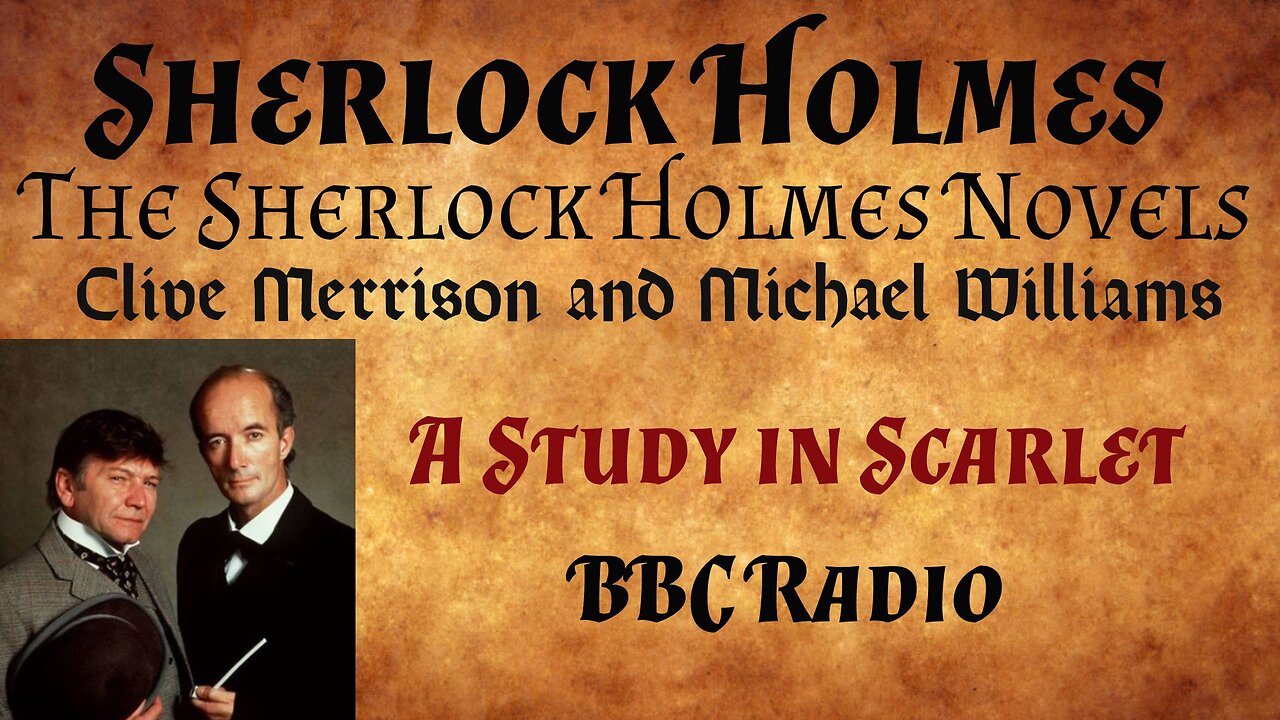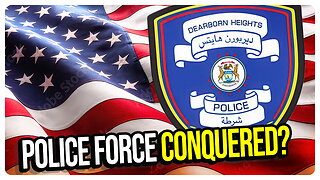Premium Only Content

Sherlock Holmes in a Study in Scarlet (Radio)
Sir Arthur Conan Doyle wrote 4 novels about Sherlock Holmes. (1 - A Study in Scarlet, 2 - The Sign of The Four, 3 - The Hound of the Baskervilles, 4 - The Valley of Fear.
(2) The Adventures of Sherlock Holmes, (12 short stories) followed the novels.
(3) The Memoirs of Sherlock Holmes, (11 stories) followed by
(4) The Return of Sherlock Holmes, 13 stories.
(5) His Last Bow, 8 stories followed by
(6) The Casebook of Sherlock Holmes, 12 stories and finally
(7) The Further Adventures of Sherlock Holmes, 10 stories by the BBC. All other Holmes stories would fall under this banner.
A Study in Scarlet is an 1887 detective novel by British writer Arthur Conan Doyle. The story marks the first appearance of Sherlock Holmes and Dr. Watson, who would become the most famous detective duo in literature. The book's title derives from a speech given by Holmes, a consulting detective, to his friend and chronicler Watson on the nature of his work, in which he describes the story's murder investigation as his "study in scarlet": "There's the scarlet thread of murder running through the colorless skein of life, and our duty is to unravel it, and isolate it, and expose every inch of it."
The story, and its main characters, attracted little public interest when it first appeared. Eleven complete copies of the magazine in which the story first appeared, Beeton's Christmas Annual for 1887, are known to exist now, which have considerable value.[2] Although Conan Doyle wrote 56 short stories featuring Holmes, A Study in Scarlet is one of only four full-length novels in the original canon. The novel was followed by The Sign of the Four, published in 1890. A Study in Scarlet was the first work of detective fiction to incorporate the magnifying glass as an investigative tool.
Part I: The Reminiscences of Watson
In 1881, Doctor John Watson returns to London after serving in the Second Anglo-Afghan War and starts looking for a place to live. An old friend tells him that Sherlock Holmes is looking for someone to split the rent at a flat at 221B Baker Street but cautions Watson about Holmes's eccentricities. Holmes and Watson meet and, after assessing each other and the rooms, they move in. Holmes is a "consulting detective", and his frequent guests are clients. After a demonstration of Holmes's deductive skills, Watson's disbelief turns into astonishment.
A telegram requests a consultation in a murder case. Watson accompanies Holmes to the crime scene, an abandoned house on Brixton Road. Inspectors Gregson and Lestrade are already on the scene. The victim is Enoch Drebber of Cleveland, Ohio, and documents found on his person reveal that he has a secretary, Joseph Stangerson. On one wall, written in red, is "RACHE" (German for "revenge"), which Holmes dismisses as a ploy to fool the police. He deduces that the victim died from poison and supplies a description of the murderer. Upon moving Drebber's body, they discover a woman's gold wedding ring.
Part II: "The Country of the Saints"
In Utah's Salt Lake Valley in 1847, John Ferrier and a little girl named Lucy, the only survivors of a small party of pioneers, are rescued from death by a party of Latter-day Saints led by Brigham Young, but only on the condition that they adopt and live under the Mormon faith. Years later in 1860, a now-grown Lucy befriends and falls in love with Jefferson Hope. However, Young forbids her from marrying outside the faith and demands that she marry either Joseph Stangerson or Enoch Drebber, both sons of members of the church's Council of Four. Ferrier, who has adopted Lucy and sworn never to marry his daughter to a Mormon, sends word to Hope.
Lucy is given one month to choose between her suitors. Hope arrives on the eve of the last day, and they all escape under cover of darkness. The Mormons intercept the escapees while Hope is away hunting, as their food had run out. Ferrier is killed by Stangerson while Lucy is forcibly married to Drebber and dies a month later from a broken heart.
Publication
Arthur Conan Doyle wrote the novel at the age of 27 in less than three weeks. As a doctor in general practice in Southsea, Hampshire, he had already published short stories in several magazines of the day, such as the periodical London Society. The story was originally titled A Tangled Skein and was eventually published by Ward Lock & Co. in the 1887 edition of Beeton's Christmas Annual, after many rejections. Conan Doyle had pressed for royalty but instead received £25 in return for the full rights (equivalent to £3,371.95 considering inflation). It was illustrated by David Henry Friston.
The novel was first published as a book in July 1888 by Ward, Lock & Co, and featured drawings by the author's father, Charles Doyle. In 1890, J. B. Lippincott & Co. released the first American version. Another edition published in 1891 by Ward, Lock & Bowden Limited (formerly Ward, Lock & Co.) was illustrated by George Hutchinson. A German edition of the novel published in 1902 was illustrated by Richard Gutschmidt. Numerous further editions, translations and dramatizations have appeared since.
Depiction of Mormonism
According to a Salt Lake City newspaper article, when Conan Doyle was asked about his depiction of the Latter-day Saints' organization as being steeped in kidnapping, murder and enslavement, he said: "all I said about the Danite Band and the murders is historical so I cannot withdraw that, though it is likely that in a work of fiction it is stated more luridly than in a work of history. It's best to let the matter rest". Conan Doyle's daughter has stated: "You know, father would be the first to admit that his first Sherlock Holmes novel was full of errors about the Mormons."] Historians speculate that "Conan Doyle, a voracious reader, would have access to books by Fannie Stenhouse, William A. Hickman, William Jarman, John Hyde and Ann Eliza Young, among others", in explaining the author's early perspective on Mormonism.
A Study in Scarlet was adapted as the first two episodes of the BBC's complete Sherlock Holmes 1989–1998 radio series. The two-part adaptation aired on Radio 4 in 1989, dramatised by Bert Coules and starring Clive Merrison as Holmes, Michael Williams as Watson, Donald Gee as Inspector Lestrade, and John Moffatt as Inspector Gregson.
-
 13:53
13:53
TundraTactical
4 hours ago $0.58 earnedFudd Finder : 11 Questions Second Amendment Questions (And Roasts) to Ask Your Friends
13.5K -
 LIVE
LIVE
Wayne Allyn Root | WAR Zone
6 hours agoWAR Zone LIVE | 5 SEPTEMBER 2025
132 watching -
 1:39:50
1:39:50
The White House
6 hours agoPresident Trump Makes Announcements, Sep. 5, 2025
27.6K25 -

Red Pill News
4 hours agoBombshell Biden Docs Invalidate Autopen Pardons on Red Pill News Live
24.9K15 -
 9:36
9:36
Silver Dragons
3 hours agoGold Price NEW ALL TIME HIGH - $5,000 GOLD NEXT?
12.5K6 -
 LIVE
LIVE
LFA TV
12 hours agoLFA TV ALL DAY STREAM - FRIDAY 9/5/25
824 watching -
 13:43
13:43
The Kevin Trudeau Show Limitless
2 days agoClassified File 3 | Kevin Trudeau EXPOSES Secret Society Brainwave Training
94.3K19 -
 1:11:24
1:11:24
vivafrei
7 hours agoDearborn Heights Police Have Been CONQUERED! Gender Madness on PASSPORTS! Canada Stuff & MORE!
90.7K56 -
 1:44:43
1:44:43
The Quartering
6 hours agoConservative Scam Busted, Black Fatigue Hits Airlines, Kimmel Meltdown
114K48 -
 39:07
39:07
Tudor Dixon
2 hours agoRFK Jr., Big Pharma, and the Hidden Risks of SSRIs in Pregnancy | The Tudor Dixon Podcast
7.2K1